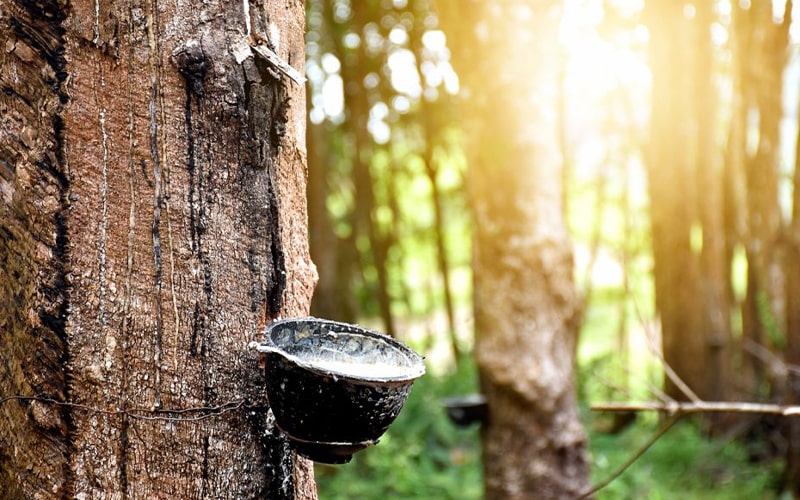Rubber trees were first discovered by the Olmec, Mayans, and the Aztecs. The tree is also known as the “Para Rubber Tree” or the “Sharinga Tree”. Rubber trees are found in low- altitudes in wetlands, riparian zones, and forest gaps. They are commonly found in Vietnam, Sri Lanka, China, India, Papua New Guinea in Asia, and Liberia and Gabon in Africa. The seeds from these trees were transported to the rubber plantations in Europe by explorers and colonists. Joseph Priestley is credited as the one who coined the name “rubber” after realizing he could use the extract to rub off the pencil marks.
The botanical name of the rubber tree is Hevea brasilienis. It belongs to the genus Euphorbiaceae. It is a tropical tree that grows to a height of 30 meters – 40 meters and has a leafy crown. Furthermore, it has a cylindrical trunk that is swollen towards the base. Rubber trees that are grown in plantations grow only to a height of up to 25 meters because they are tapped for latex regularly. The leaves are arranged in spirals, and each leaf has three leaflets. The flowers are small and have no petals. The flowers of the rubber tree are cream to yellow and have a pungent smell. The male and female flowers are found on the same tree. The fruit of the rubber tree is a capsule and explodes to release and disperse the seeds. The seeds are scattered 30 meters away from the tree.
The rubber trees can be tapped for latex only after about six years of growth. To collect the latex, a thin cut is made diagonally on the tree trunk, and the silver bark is removed. The latex flows out from the cut into a collecting chute and runs into a bucket that is hung below the cut. The latex keeps flowing for about six hours. The rubber tree is allowed to rest for six days, and another fresh cut is made to collect latex.
Harvesting latex from the tree does not cause any harm to the tree. After collection, the latex is processed to make sheets of rubber, which are then sent to manufacturing factories. There are two types of rubber, natural rubber from rubber trees and synthetic rubber made by using petrochemicals. Crude oil is the primary raw material used in the production of synthetic rubber.
Uses Of The Rubber Tree
Natural rubber is used in the production of tires. Around 70% of the world’s natural rubber goes into manufacturing tires for the automobile industry. The natural rubber has to be vulcanized before using them to manufacture tires. Vulcanization is the process of heating natural rubber with sulfur to make it strong and durable. Natural Rubber is also used to manufacture the following – conveyor belts, surgeon’s gloves, marine products, windshield wipers, rubber gaskets, hose and tubing, vibration isolators, shock mounts, electrical components, tubing for orthodontic bands.


Comments are closed.